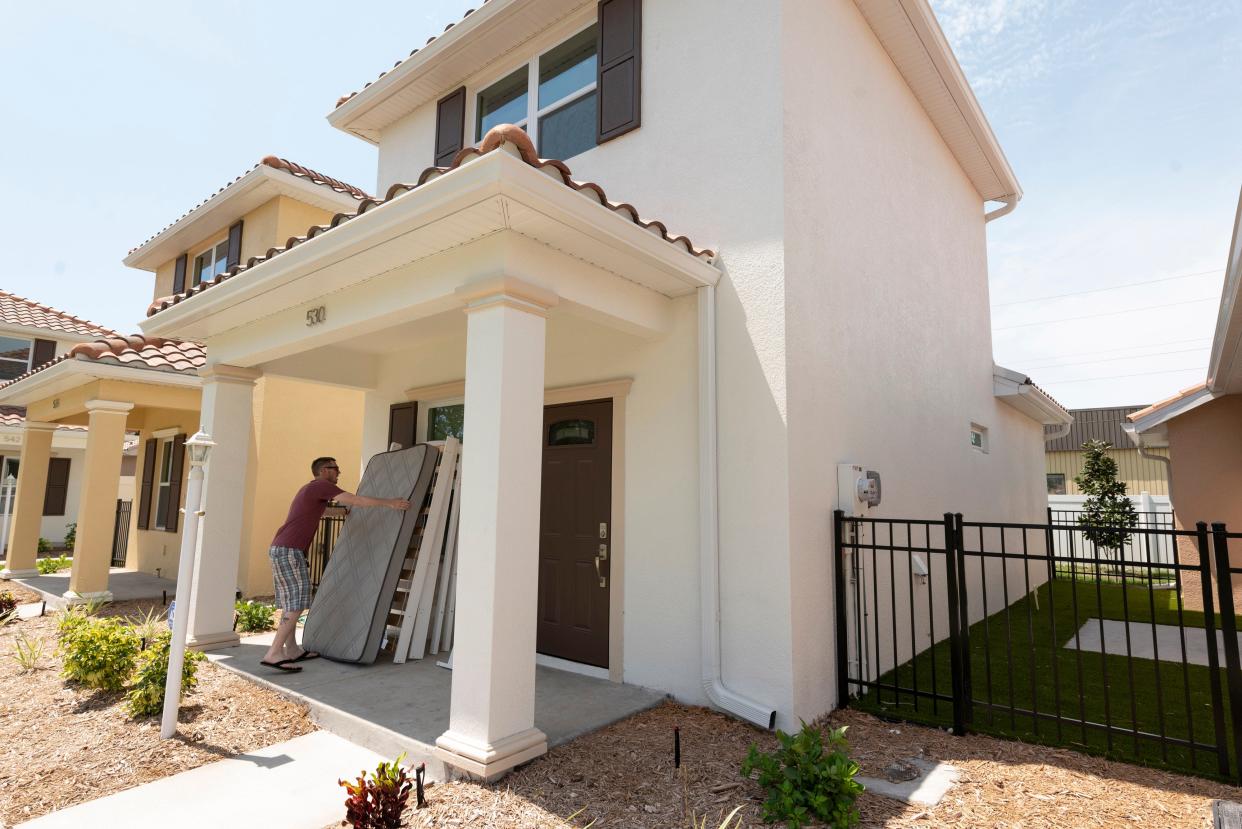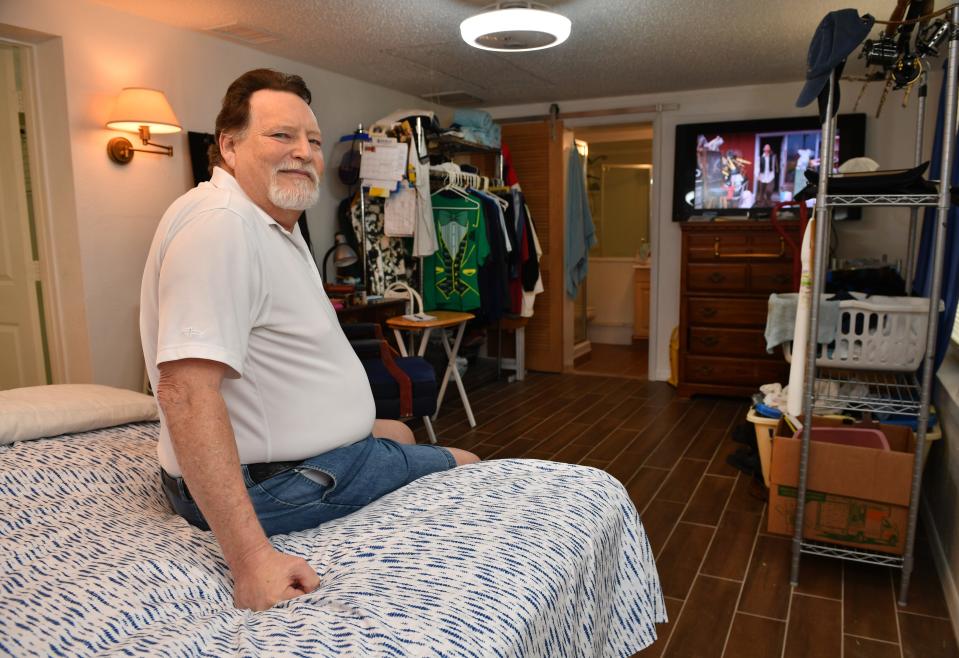Nashville housing model might help thousands in Sarasota-Manatee, experts hope

Amid skyrocketing rents and surging calls for help, local housing advocates are pursuing an innovative Nashville model for increasing housing access that could potentially assist thousands of local families facing homelessness.
The Nashville project, titled Low Barrier Housing Collective, is a collaboration between social service agencies and private property owners who receive incentives in exchange for lowering or removing rental obstacles that often confront low-income individuals and working families.
In operation since last fall, the collective sprang from a housing crisis similar to that facing Sarasota and Manatee counties, with Nashville rents spiking between 30% and 50% and renters often given less than 60-day notices to leave their homes, said Lizzie Goddard, architect of Nashville’s model.
Affordable Housing Crisis: As rents go up and evictions increase, Sarasota's seniors struggle to find places to live
Rent Spikes: United Way Suncoast's new data shows half of all local renters now rent-burdened
While pushing for long-term plans to construct more affordable housing, Nashville community leaders and nonprofits sprang into action to find short-term solutions to the emergency as well, she added.
“We can’t tell our clients, ‘Hey, if you can just hold on a few years while more units are built, that would be great,’” Goddard said during a recent virtual presentation to area housing advocates and service providers.
For local housing advocates, Nashville's results – already capturing national attention – were impressive.

In just six months, from September to March, the number of private rental units available to help service providers find housing for homeless or nearly homeless distressed renters soared by almost 68%. That amounts to an additional 6,700 units, for a total of about 16,500 homes, Goddard said.
What’s more, the time it takes for many Section 8 voucher holders to find an affordable apartment – a delay climbing as high as three months or more during the crisis – has been steadily declining, she said.
Now, instead of Goddard and her colleagues scouring Craigslist or apartments.com for property owners willing to participate in the collective, landlords are finding them through word of mouth.
“They are actually coming to us, saying, ‘Hey, I have a few units coming up, how do I get involved,’ and that is super exciting,” she said.
Sarasota-Manatee housing advocates and nonprofits agree.
“As far as I’m concerned, I think it is one of the best models out there right now,” Chris Johnson, chief executive officer of the Suncoast Partnership to End Homelessness, said following the meeting and Goddard’s presentation.
Housing Help: Sarasota Housing Authority opens waiting list for Section 8 vouchers
Johnson, as head of the lead agency for the Continuum of Care network on homelessness issues for Sarasota and Manatee counties, had invited Goddard to make her presentation at several online meetings for local community leaders.
Afterward, Johnson said members of the Continuum of Care have reached a consensus to start working on how to adapt a version of the Nashville model for this region.
Possibly no place needs it more than Sarasota and Manatee counties, ranked by the Apartment List as having the fastest-increasing rents in the nation, year-over-year – 48.4% for Sarasota County and 47.7% for Manatee.
For the past several months, nonprofits, philanthropists, real estate agents and community leaders have been holding meetings – sometimes weekly – on housing solutions, trying to figure out what to do, Johnson said.
“The market has shifted so high, so quickly, our community didn’t have a response for that,” he said.
Since the fall, area agencies in the Continuum of Care have seen a 25% increase in families and individuals seeking homelessness services, with almost 2,000 people accessing services, Johnson said.
That does not include people on the brink of losing their housing – a number, he conceded, “that is going to be astronomical.”
In March, United Way Suncoast released new data showing that half of all renting households in a five-county area that includes Sarasota and Manatee are “rent-burdened” – or paying more than 30% of their monthly income in rent.

“Those that we are talking about in housing instability and currently losing housing, these are our health care workers, our school workers, our teachers and their families, our service workers,” Johnson added.
Rents: Rents for Sarasota, Bradenton and North Port area among most expensive for midsize metros in US
In recent weeks, the Sarasota County Commission agreed to contribute $25 million in its allotted federal pandemic relief funds to help develop almost 700 new units of affordable housing, while the Manatee County Commission approved a series of major initiatives to address affordable housing and homelessness.
But many of those plans will take years to come to fruition in a region plagued by a severe lack of affordable housing that long predated the immediate crisis.
“Our community is known for its philanthropy and for agencies that care, that work tirelessly to try to solve these problems,” he said. “We need the broader community, we need to plead to the hearts of landlords who we know are out there who could offer some of those units.”
That’s where Nashville’s model comes into play.
While it appeals to the hearts of landlords – many of whom suffered losses themselves during pandemic-era eviction moratoriums – it also has to make sense for their bottom lines, said Goddard.
“We are putting ourselves in the shoes of owners,” Goddard said, describing the approach to have landlords lower screening criteria for homeless applicants. “If you are going to take a chance on them, here is how we are going to take care of you.”
How the Nashville model works
Using federal pandemic relief dollars, rental assistance funds, philanthropic donations as well as additional rental vouchers for residents, Nashville’s housing collective presents a portfolio of incentives to property owners to mitigate or ease their risk.
In exchange, landlords relax screening criteria and other barriers for renters experiencing homelessness – barriers that can typically include low income, previous evictions, poor credit or criminal history, restricting their housing options in an already tight market, Goddard said.
The incentives for landlords are as follows:
$1,000 on top of the deposit in the case of damages to the property, and up to two months rent if the renter breaks the lease
$2,000 sign-up bonus for the first five units leased through the collective
A large pool of potential applicants
An online database to share information with more than two dozen nonprofits
Access to community mediation with the tenant, if needed
And – importantly – wraparound case management from the nonprofits to help the renters with housing stability on everything from employment support to health services
“We’re not asking landlords to be social workers,” she said. “That’s what our service providers do.”
So far, since the fall, between 200 and 300 households have been placed in permanent housing through the housing collective, Goddard told the Sarasota Herald-Tribune. All of the referrals through the collective require a minimum of a 12-month lease. Properties are also screened and inspected to help safeguard tenants' rights.
Most renters through the collective – about 70% – are on some sort of rental assistance vouchers while the remaining residents receive help from rapid rehousing program funds that taper over time and get replaced by vouchers or the tenants' employment income, she said.
Goddard, who now works as a consultant for Nashville and other communities nationwide that are seeking to replicate the housing collective, added that like countless residents in the Sarasota and Manatee area, many applicants amid the current housing crisis are facing homelessness for the first time.
“They never before had to ask for assistance at all,” she said. “They don’t understand how to navigate the system or access resources available to them.”
Johnson of the Suncoast Partnership said a local version of the model has enormous potential to help not only the homeless but also thousands of individuals and families currently with a roof over their heads but struggling to survive in the housing crisis.
He envisions that with the area's strong philanthropic community, private donations could be poured into the model to serve a larger pool of people -- supplementing government-backed vouchers to provide more badly needed workforce housing.
The help can't come fast enough, said P.J. Brooks, chief operating officer of the local nonprofit Community Assisted and Supported Living, or CASL.
To meet the rapidly intensifying demand for workforce housing, CASL has had to expand beyond its traditional mission of providing affordable and permanent homes for adults with developmental and mental health issues.
“Now we’re looking at people entering homelessness that would never have been our clients to serve,” he said.
With some minor tweaking, Brooks said he thinks the Nashville model could help meet that demand for thousands of local families.
“We have to start the conversation and the dialogue and the brainstorming,” Brooks said. “All of us coming together to do that is going to have the best hope.”
This story comes from a partnership between the Sarasota Herald-Tribune and the Community Foundation of Sarasota County. Saundra Amrhein covers the Season of Sharing campaign, along with issues surrounding housing, utilities, child care and transportation in the area. She can be reached at samrhein@gannett.com.
This article originally appeared on Sarasota Herald-Tribune: A Housing Collective may help Sarasota Manatee residents housing crisis

